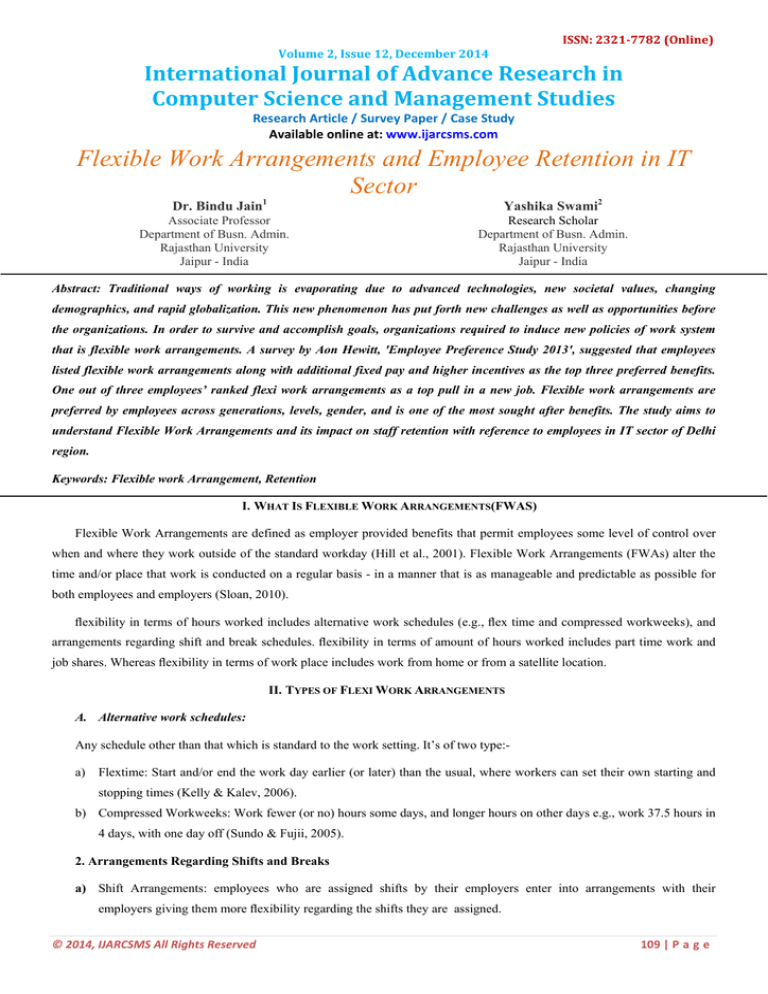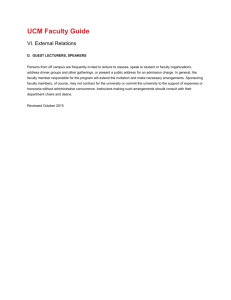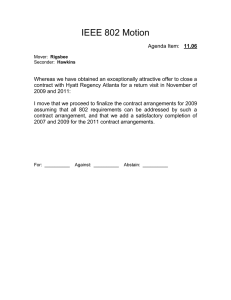
ISSN: 2321­7782 (Online) Volume 2, Issue 12, December 2014 International Journal of Advance Research in Computer Science and Management Studies Research Article / Survey Paper / Case Study Available online at: www.ijarcsms.com
Flexible Work Arrangements and Employee Retention in IT
Sector
Dr. Bindu Jain1
Yashika Swami2
Associate Professor
Department of Busn. Admin.
Rajasthan University
Jaipur - India
Research Scholar
Department of Busn. Admin.
Rajasthan University
Jaipur - India
Abstract: Traditional ways of working is evaporating due to advanced technologies, new societal values, changing
demographics, and rapid globalization. This new phenomenon has put forth new challenges as well as opportunities before
the organizations. In order to survive and accomplish goals, organizations required to induce new policies of work system
that is flexible work arrangements. A survey by Aon Hewitt, 'Employee Preference Study 2013', suggested that employees
listed flexible work arrangements along with additional fixed pay and higher incentives as the top three preferred benefits.
One out of three employees’ ranked flexi work arrangements as a top pull in a new job. Flexible work arrangements are
preferred by employees across generations, levels, gender, and is one of the most sought after benefits. The study aims to
understand Flexible Work Arrangements and its impact on staff retention with reference to employees in IT sector of Delhi
region.
Keywords: Flexible work Arrangement, Retention
I. WHAT IS FLEXIBLE WORK ARRANGEMENTS(FWAS)
Flexible Work Arrangements are defined as employer provided benefits that permit employees some level of control over
when and where they work outside of the standard workday (Hill et al., 2001). Flexible Work Arrangements (FWAs) alter the
time and/or place that work is conducted on a regular basis - in a manner that is as manageable and predictable as possible for
both employees and employers (Sloan, 2010).
flexibility in terms of hours worked includes alternative work schedules (e.g., flex time and compressed workweeks), and
arrangements regarding shift and break schedules. flexibility in terms of amount of hours worked includes part time work and
job shares. Whereas flexibility in terms of work place includes work from home or from a satellite location.
II. TYPES OF FLEXI WORK ARRANGEMENTS
A. Alternative work schedules:
Any schedule other than that which is standard to the work setting. It’s of two type:a)
Flextime: Start and/or end the work day earlier (or later) than the usual, where workers can set their own starting and
stopping times (Kelly & Kalev, 2006).
b) Compressed Workweeks: Work fewer (or no) hours some days, and longer hours on other days e.g., work 37.5 hours in
4 days, with one day off (Sundo & Fujii, 2005).
2. Arrangements Regarding Shifts and Breaks
a) Shift Arrangements: employees who are assigned shifts by their employers enter into arrangements with their
employers giving them more flexibility regarding the shifts they are assigned.
© 2014, IJARCSMS All Rights Reserved 109 | P a g e Dr. Bindu et al.
International Journal of Advance Research in Computer Science and Management Studies
Volume 2, Issue 12, December 2014 pg. 109-116
b) Break Arrangements: employees who generally can only take assigned breaks enter into an arrangement with their
employers giving them more flexibility over when they take breaks.
B. Flexibility in the amount of Hours Worked
1.
Part Time Work/Reduced Hours Schedule: Work less than 30 hours a week.
2.
Transition Period Part Time: employees gradually return to work after a major life event (e.g., birth or adoption of a
child) by working part time for a set period and eventually returning to full time work
3.
Job Shares: Share the responsibility and benefits of one full-time position with another employee (Gottlieb et al.,
1998).
4.
Part-year Work: employees work only a certain number of months per year.
C. Flexibility in the place of work
1.
Telework/Home Work: employees work remotely from their own homes, using a telecommunications connection to
the workplace if necessary.
2.
Telework/Satellite Location: employees work remotely from a designated satellite work center.
3.
Alternating Location: employees work part-year in one location and part-year in a second location.
III. ADVANTAGES OF FLEXIBLE WORK ARRANGEMENTS FOR EMPLOYERS
Flexible work arrangements are beneficial for employers in the form of increase productivity, job satisfaction, employee
morale, reduce absenteeism etc.
»
Increase job satisfaction of the employees (Baltes et al., 1999)
»
Increased employee morale, engagement to the organization.
»
Increase organizational commitment (Glass & Finley, 2002)
»
Increased productivity of the organization (Pierce & Newstrom, 1980)
»
Decreased absenteeism and turnover (Hyland, 2000)
»
And increase applicant attraction to an organizations offering flexitime (Rau & Hyland, 2002).
IV. ADVANTAGES OF FLEXIBLE WORK ARRANGEMENTS FOR EMPLOYEES
Flexible work schedule have been recommended to help employee reduce work–family conflict by allowing them more
control over their work schedule. The following points summarize the benefit of FWAs to employees.
»
Employees feel less stressed when they have more control over their schedule (Almer & Kaplan, 2002);
»
Increased energy and creativity (Schaefer, 2005);
»
Employees perceive that flexible working makes them “happy” and that there are attitudinal/behavioral links between
this happiness, discretionary behavior and a number of performance outcomes (Atkinson & Hall, 2011);
»
Achieving work/life balance for many office-based employees and less workfamily conflict (Hayman, 2009).
V. OBJECTIVE OF THE STUDY
»
To thoroughly study the concept of Flexible works Arrangements.
»
To study employees prospective towards Flexi work arrangements.
© 2014, IJARCSMS All Rights Reserved ISSN: 2321‐7782 (Online) 110 | P a g e Dr. Bindu et al.
»
International Journal of Advance Research in Computer Science and Management Studies
Volume 2, Issue 12, December 2014 pg. 109-116
To study the various flexible work strategies implemented by the organizations. .
»
To suggest suitable measures to improve work life balance of female employees.
VI. METHODOLOGY
UNIVERSE OF THE STUDY
Employees from IT sector organizations (delhi) constitute the universe.
SAMPLE DESIGN
The sample design of this study will be non-probability convenience sampling method University). The number of
respondents is 100.
METHOD OF STUDY
The research study will be of exploratory type.
DATA COLLECTION
Primary data- In order to collect the primary data in this study, questionnaire and interview method is used.
Secondary data- Research studies conducted in this area and related areas in different universities, books, magazines and
journals, websites dealing with this subject and various reports published by institutions working in this field is the source of
secondary data collection.
DATA ANALYSIS & INTERPRETATION
I Types of flexi work arrangements available to the employees
Types of flexi work arrangements
Response (yes)
No
Part time
10
90
Flexi time
55
45
Staggered hours
75
25
Compressed work week
40
60
Annualized hours
0
100
Time in lieu
80
20
Job sharing
16
84
Home working/ Teleworking
73
37
Sabbatical/ career leaves
77
33
120
100
80
60
40
20
0
no
yes
© 2014, IJARCSMS All Rights Reserved ISSN: 2321‐7782 (Online) 111 | P a g e Dr. Bindu et al.
International Journal of Advance Research in Computer Science and Management Studies
Volume 2, Issue 12, December 2014 pg. 109-116
The above chart shows that flexi time, staggered hours, compressed work week and time in lieu, home working or work
from home, sabbatical leaves are facilitated to employees more in comparison to other strategies like part time, annualized
hours, job sharing. The percentage of implementing these strategies should be increase kept in mind the benefits of flexi work
arrangements.
II Flexible working policy helps to balance work life.
Flexible working policy helps to balance
work life.
yes
no
100
0
Flexible working policy helps to balance work life.
yes
no
The above chart divulge that flexible working policy do help in creating work life balance.
Statement
III Flexible working policy helps to reduce stress of employees.
Response (yes)
No
Flexible working policy helps to reduce
stress of employees.
96
4
Flexible working policy helps to reduce stress of employees.
yes
no
© 2014, IJARCSMS All Rights Reserved ISSN: 2321‐7782 (Online) 112 | P a g e Dr. Bindu et al.
International Journal of Advance Research in Computer Science and Management Studies
Volume 2, Issue 12, December 2014 pg. 109-116
Flexible work police plays an important role in reducing stress of employees as shown in the chart above.
Statement
IV you will not accept a job offer if it ruled out Flexible working policy.
Response(yes)
No
You will not accept a job offer if it ruled
out Flexible working policy.
65
35
you will not accept a job offer if it ruled out Flexible
working policy.
yes
no
The above chart clearly indicates that employees are very much interested in working with an organization facilitating
flexible work arrangements.
V Flexible working policy is a reason that I prefer to stay longer in current organization.
Statement
Response (yes)
no
Flexible working policy is a reason that I
prefer to stay longer in current
organization.
92
8
Flexible working policy is a reason that I prefer to stay longer
in current organization.
yes
n0
The chart above reveals that employees would prefer to stay for a longer period of time if flexible work arrangements are
practiced by the institution. This also equally draws our attention to the point that how much importance employees give to
flexible work arrangements.
© 2014, IJARCSMS All Rights Reserved ISSN: 2321‐7782 (Online) 113 | P a g e Dr. Bindu et al.
International Journal of Advance Research in Computer Science and Management Studies
Volume 2, Issue 12, December 2014 pg. 109-116
VI Flexible working policy has improved staff retention.
Statement
Response (yes)
no
Flexible working policy has improved
staff retention.
87
13
Flexible working policy has improved staff retention.
yes
no
The chart above shows that flexible work policy has improved staff retention in the organizations. It’s because of the FWP that
employees would not leave their respective institutions.
VII Flexible working policy makes employees more committed towards organization.
Statement
Response (yes)
no
Flexible working policy makes
94
6
employees more committed towards
organization
Flexible working policy makes employees more committed
towards organization
yes
no
The benefits of flexible work police have made employees more loyal and committed towards the organization are
confirmed by the chart drawn above.
© 2014, IJARCSMS All Rights Reserved ISSN: 2321‐7782 (Online) 114 | P a g e Dr. Bindu et al.
International Journal of Advance Research in Computer Science and Management Studies
Volume 2, Issue 12, December 2014 pg. 109-116
VII. ANALYSIS AND INTERPRETATION
The above data analysis divulged that the employees give due weight age to flexi work arrangements. As indicated in study
that employees feel that FWL helps them to balance work and life, reduce stress, longer tenure in the organization, more
committed towards the organization. The previous studies as mentioned in this paper show that organizations are also benefited
in the form of increase job satisfaction, productivity, employee morale & employee engagement, reduce absenteeism &
turnover, attract and retain talent employees. The study also reveals an interesting fact that employees prefer to stay longer in
the institution if facilitated with flexi work arrangements.
VIII. CONCLUSION AND SUGGESTION
In this growing economies and competitive market, Flexible work arrangements emerge as an important HR strategy to
attract and retain talented employees in the institution. As the new work force that is knowledge workers put great value to Flexi
work arrangements and see them as an important perk. Businesses of all sizes report that flexible working improves staff
retention, with larger businesses marginally more likely to appreciate the value of flexible working for both hiring top talent and
staff retention (both 77%)(Regus 2014). There are some suggestions to improve employee retention while keeping flexi work
arrangements in perspective.
1.
All organizations are not implementing FWA, its time demand to consider it as important and powerful tool to attract
and retain employees.
2.
All the options in respect of FWA are required to be implemented.
3.
If not all options of FWA are likely to be implemented than institute make a survey as to find out which are most
beneficial and hence implement them.
4.
Employees should be properly educated regarding FWA as to who can avail, under what circumstances, the authority
who can give permission etc., to make most of this policy.
The organizations should provide its employees certain amount of flexibility so that they are able to balance their work life
thus reducing absenteeism, attrition rate and increasing productivity. It is always a known fact that if a company takes care of
the needs of the employees, the employee will serve the company better.
ACKNOWLEDGEMENT
The author is greatly obliged to BCUD, Savitribai Phule Pune University Pune for the financial support through Minor
Research Project Scheme. The author wishes to thank Dr. S. C. Mehrotra, Dr. J. B. Shinde and Prin. P. A. Lawande for valuable
guidance and encouragement.
References
1.
Almer, E.D. & Kaplan, S.E. (2002). The effects of flexible work arrangements on stressors, burnout, and behavioral job outcomes in public accounting.
Behavioral Research in Accounting, Vol. 14, pp. 1-34.
2.
Atkinson, C. & Hall, L. (2011). Flexible Working and Happiness in the National Health Service. Employee Relations, Vol. 33, No. 2 available at
www.emeraldinsight.com/0142-5455.htm
3.
Baltes, B.B., Briggs, T.E., Huff, J.W., Wright, J.A., Neuman, G.A. (1999). Flexible and compressed workweek schedules: a meta-analysis of their effects
on work related criteria. Journal of Applied Psychology 84, 496–513.
4.
Glass, J., & Finley, A. (2002). Coverage and effectiveness of family-responsive workplace policies [Special issue: Changing views of work and family
roles]. Human Resource Management Review, 12, 313-337.
5.
Gottlieb, B., H., Kelloway, E.K., & Barham, E. (1998). Flexible Work Arrangements: Managing the Work- Family Boundary. West Susse PO19 1UD,
England: John Wiley &Sons Ltd.
6.
Hayman, J., R. (2009). Flexible Work Arrangements: Exploring the Linkages between Perceived Usability of Flexible Work Schedules and Work/Life
Balance. Community, Work & Family, Vol. 12, No. 3, 327-338.
© 2014, IJARCSMS All Rights Reserved ISSN: 2321‐7782 (Online) 115 | P a g e Dr. Bindu et al.
International Journal of Advance Research in Computer Science and Management Studies
Volume 2, Issue 12, December 2014 pg. 109-116
7.
Hill, E. J., Hawkins, A. J., Ferris, M., & Weitzman, M. (2001). Finding and extra day a week: The positive influence of perceived job flexibility on work
and family life balance. Family Relations, 50, 49–58.
8.
Hyland, M. M. (2000). Flexibility in work arrangements: How availability, preferences, and use affect business outcomes. Dissertation Abstracts
International, Section A: Humanities and Social Sciences, 60, 3716.
9.
Kelly, E.L. & Kalev, A. (2006). Managing flexible work arrangements in US organizations: formalized discretion or ‘a right to ask’. Socio-Economic
Review, Page 1 of 38.
10. Pierce, J., Newstrom, Dunham, R., & Barber, A. (1989). Alternative work schedules Needham Heights. MA: Allyn & Bacon.
11. Rau B. L., Hyland M. A. (2002). Role conflict and flexible work arrangements: The effects on applicant attraction. Personnel Psychology 55: 111–36.
12. Schaefer, P. (2005). Flexible Work Arrangements: Employer Solutions to Common Problems. Management and Human Resources. available at:
http://www.businessknowhow.com/manage/flex-work.htm, last visit at 9/1/2012, 11:00 am.
13. Sloan, A. P. (2010). Public Policy Platform on Flexible Work Arrangements. Public policy initiative at Georgetown Law, Available at:
http://workplaceflexibility2010.org/images/uploads/reports/report_1.pdf.
14. Sundo, M., & Fujii, S. (2005). The Effects of a Compressed Working Week on Commuters_ Daily Activity Patterns. Transportation Research Part A 39,
835–848.
15. Regus - a Survey Firm. (n.d.). Flexible working in Indian IT industry. Jan 2014.
AUTHOR(S) PROFILE
Dr. Bindu Jain has been working as Associate Professor in Maharani College, Department of
Business Administration, University of Rajasthan, jaipur since 1992. She has done
M.com.,M.Phil, Ph.D from University of Rajasthan, Jaipur. She is a research supervisor to
students pursuing their doctoral degree. Her area of interest is General Management, HRM &
Marketing. She has to her credit a large number of Research papers in national and International
journals. She has authored books on computer science.
Yashika Swami is a Research scholar (Department of Business Administration,University of
Rajasthan,jaipur), has received M.A English degree from Kurukshetra University, M.B.A degree
in Human Resourse and Marketing Management from Banasthali University, and UGC NET
qualified in HR in 2007,2009,2010, respectively.She is pursuing Ph.D on the topic entitle
“Quality of Work Life in the Universities ( A Case Study of Selected Universities of Rajasthan)”
under the supervision of Dr. Bindu jain from the University of Rajasthan. She has been awarded
Doctoral Fellowship offered by ICSSR(Indian council of Social Science research) for her Ph.D
research work. She has 2 years of teaching experience.
© 2014, IJARCSMS All Rights Reserved ISSN: 2321‐7782 (Online) 116 | P a g e


